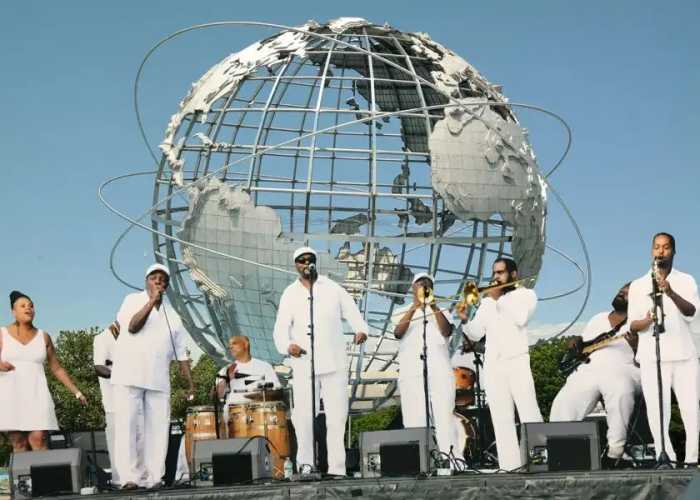On Saturday, Aug. 20, the St. John’s Place sidewalk in Crown Heights outside of Five Myles Gallery Space became an outdoor theatre. When the folding chairs were filled, culture vultures perched themselves on the cement while others stood behind stretching into the street for an evening entitled “Pwezi Anba Tonel” (Poetry in the Pavilion), An Evening of Haitian Poetry & Music.
The evening was introduced by two Poetry Ambassadors: Regine Roumain of Haiti Cultural Exchange who partnered with City Lore and Bowery Arts + Science (Poetry Club) and the Gallery to organize the event, and also Lois Wilckens of another collaborator, La Troupe Makandal.
Wilckens made special note of the day, specifically chosen to fall between the dates of the ceremony Bwa Kayiman that sparked the Haitian Revolution, Aug. 14, and Aug. 22, the date the uprising began.
The five-piece La Troupe Makandal played from a nook fronting the sidewalk. At the very start there was another commemoration, 35 seconds devoted to the devastating period of the Haitian earthquake.
To the percussive sounds of Makandal, Boukman’s Prayer at Bwa Kayiman in Kreyol and English were projected on the outside wall, line by line–Haitian Kreyol and English, followed by poems to the spirits of Ayizan a and La Siren.
As the band continued its heartfelt gripping rhythms, the words of Haiti’s leading poets, 19th Century’s Oswald Durand’s “Choucoune” (in Kreyol), the renowned Jacques Roumain’s “Guinea” (in French), and Felix Morriseau-Leroy’s “Down with the Candidates” (in Kreyol) appeared in white light with translation and then dissolved into specks, as new lines appeared. This dissolving flow danced like the aftermath of fireworks.
The series of poetry events is called “A White Wing Brushing the Building” and refers to this cinema of words projection from the POEMobile, always coupled with live performance and readings.
Makandal also played with the projected work of contemporary living Haitian poets Anthony Phelps, Jacqueline Beauge-Rosier, and Jean Metellus.
As the evening progressed, four local Haitian poets read their own poetry in English, Kreyol or French–the words and translation projected.
Brooklyn-born and local performing poet Jennifer Celestin led off reading “Ghede.”
Michele Voltaire Marcelin read “Ayiti” in Kreyol accompanied by only Frisner of La Troupe Makandal and also “Testament.“ The printed program also published Marceline’s “(For Gonaives),” her tribute to an earlier disaster from rain and water and wind of a hurricane.
Unplanned, Frisner accompanied in his gentle way Denize Lauture, quietly massaging and punctuating words with his magic fingers on the drum as Lauture read his “The Haitian Poet.”
It starts: Our poet is, A vodou priest, Who makes words, Sound like counchshells, Who makes words, Sound like bamboo trumpets, and who trumps words, Into beautiful Rada drumbeat.
Poet Josaphat-Robert Large who translated many of the Kreyol poems, read in French his “My Very Own Earthquake.”
Appearing on the walls: (in translation) My country of crumbled rainbows, A spider web illumined with pain, Here is my city pierced, And my history in mourning, Oh my history that was once a history of glory!
Many of the English translations of the poems projected or in the program were commissioned for the performance. Poet and translator Large wrote in the program the delight of this task, “It was also an occasion to travel through the historical path of our beautiful literature, crossing over close to 3 centuries, from 1800 to the beginning of the year 2000.”
La Troupe Makandal played a second set, this time with the projection of veves, images of Vodou symbols of the drum spirits. Time allotted for encore readings by the poets present.
When Wilckens was asked her reaction to the wonderful evening, she had but eight short words to say, “Long live the marriage of poetry and music!”





















